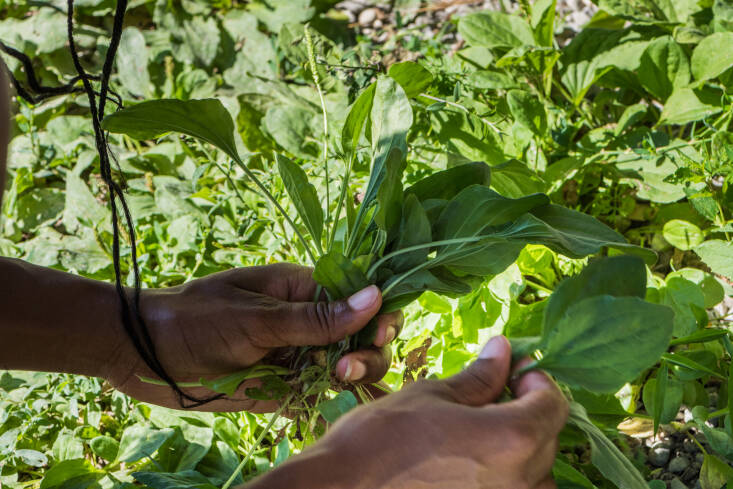If you see someone foraging berries from a tree that you thought was merely decorative, or carrying plants on the subway that do not look like florist’s flowers, stop and talk to them. They might change your perspective on the world around you. It might even be Jess Turner of Olamina Botanicals, an herbalist who is very open in engaging strangers and passersby in a conversation on the potential of plants for wellbeing.
The short ingredients list in Olamina Botanical’s First Aid Spray reveals four medicinal plants that are easy to find, growing in gutters or abandoned lots: plantain, chickweed, bidens, and feverfew. It is Jess’s mission to promote understanding between ordinary plants and people, while rekindling a connection with our better-informed ancestors.
Photography by Valery Rizzo.

“It was important for me to make the ubiquitous herbs that grow abundantly in my bioregion the basis of my First Aid Spray,” says Jess, adding that by harvesting and therefore reducing something as rampant as chickweed, she is helping the landscape in a small way. She also grows specific medicinal plants at a CSA in upstate New York and buys ingredients that are difficult to harvest in the quantities she needs from trusted herb farms.
“Chickweed and the bidens I use in the formula are not native to my region and grow with reckless abandon wherever they appear here. They are two plants you’d be hard-pressed to find anyone—even the wackiest of herbalists—actually cultivating from seed. There’s no need! They’re absolutely everywhere.”

Jess points out that plants were around for hundreds of millions of years before us. Our forebears naturally had a better appreciation of the benefits of local plants on human health: “Plants have been adapting to environmental stressors including pests, viruses, bacteria, and disease for a really long time. It’s the constituents they produce to address these challenges that provide benefit to our human bodies.”

Plantain, sometimes referred to as the mother of all herbs is one of the First Aid Spray’s vital ingredients. “It is also called the ‘green bandage’, an ode to its immense topical healing properties,” says Jess. “Plantain is astringent, antimicrobial, demulcent, cooling and anti-inflammatory. Because of its drawing properties, it can been used to pull out bee stings and infection from a wound.” For the easiest DIY application, freshly picked herbs are easy to use, without distilling or fermenting. “Just grab a leaf, chew, and apply to a sting, cut or abrasion. The enzymes in our saliva help to activate the healing properties of plantain; chewing the leaves releases the medicinal constituents in the leaves,” she says. If the idea of spit is “undignified,” the leaves can be crushed and applied straight to a wound, kept in place with gauze. “You can also take a few leaves, chop them, steep them in hot water for 15 minutes and apply that infusion as a wash to a troubled area.”

“All of the herbs in my First Aid Spray work really well at keeping microbes in check, soothing inflamed tissues and speeding our body’s healing processes. I’d be most apt to use feverfew (above) if—in addition to surface inflammation—an area of someone’s body was inflamed at a deeper level, like in the muscle tissue. In that case, I’d take fresh plant material, crush it and apply to the area, covering with a warm cloth.”

The use of a tonic and tincture can seem mysterious to the uninitiated, becoming a special-occasion treatment that languishes in a cupboard, only to be forgotten. Jess tries to overcome this abundance of caution by making her treatments irresistibly attractive to the senses, including fragrance and taste. “When I’m making tonics I work hard to make them taste delicious and interesting, with the goal of bringing a bit of delight and intrigue into someone’s day.”

“I encounter many folks who don’t really get the “why” of herbs,” says Jess, suggesting that the American palate is somewhat limited because “We’ve rubbed out the herbal traditions native to this land; separated people brought here by force from their ancestral medicine; and forgotten the herbal traditions of the lands from whence we came.”

Jess is motivated by perspectives that, she says, make her own efforts “fun, transformative and radical.” In drawing attention to the healing powers of freely-growing weeds and wildflowers which can be found on the streets, she is in effect saying: “Let’s talk about what’s growing around us that can help with the health issues we are experiencing, because of the amount of stress we are under as people from communities that have been historically marginalized.” Her approach is practical: “Let’s rediscover the ways our ancestors harnessed the power of some so-called weeds to bring ease.”

“Part of the endeavor to inspire delight on the subject of weeds, is about helping BIPOC people in cities see the abundance of medicine growing all around us. It’s an effort to reclaim the power pushing up through the blighted, throwaway spaces we’ve been forced into, in the form of plants like plantain and chickweed.”
For more on natural botanical products, see:
- Herbal Garden Visit: At Home with Slow Beauty Expert Justine Kahn, in Sausalito
- DIY Natural Remedy: Calendula Oil from Obercreek Farm
- DIY: The 7 Best Natural Mosquito Bite Remedies












Have a Question or Comment About This Post?
Join the conversation (0)